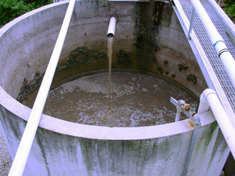
BIOREMEDIATION FOR WASTEWATER and WASTEWATER TREATMENTS SYSTEMS

| Bioremediation project in a stormwater retention pond. BOD levels can be reduced with bioremediation and the addition of microbes. |
BOD/COD Levels |
||
|
A common problem is the ability to control high BOD/COD (Biological Oxygen Demand) levels in a system. The first thought that there is not enough oxygen in the system to do its job. This is usually based on suspicions that the mechanical processes that generate air and oxygen - in relation to the volume capacity of the system, are not functioning well enough or are inadequate. Traditional methods trend to either increase the oxygen levels (dissolved oxygen) and or increase the retention capacity. This is typically the engineering solution and does not always solve the problem. In this case, the anaerobic microbes required to perform the degrading function will die if not provided with the correct balance of nutrients. As they oxidize they produce acid, which disrupts the total balance of the microbial populations. Due to the competitive nature of microbes, the non-beneficial bacteria will dominate producing an excessive level of pathogens and toxins. This will lead to "stalling" or grid-lock and high BOD's with foul odors. More information on microbes and a wastewater system
|
|